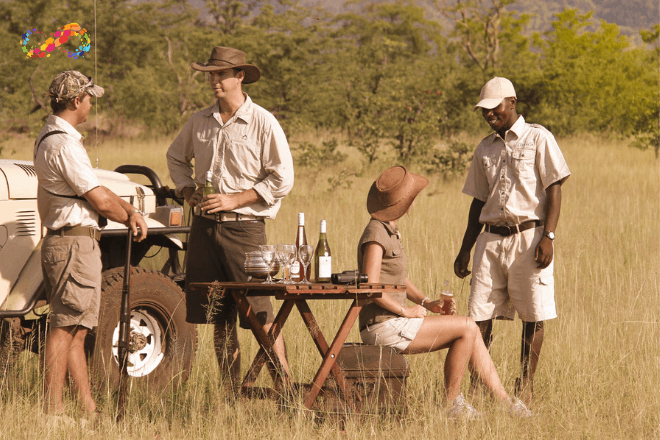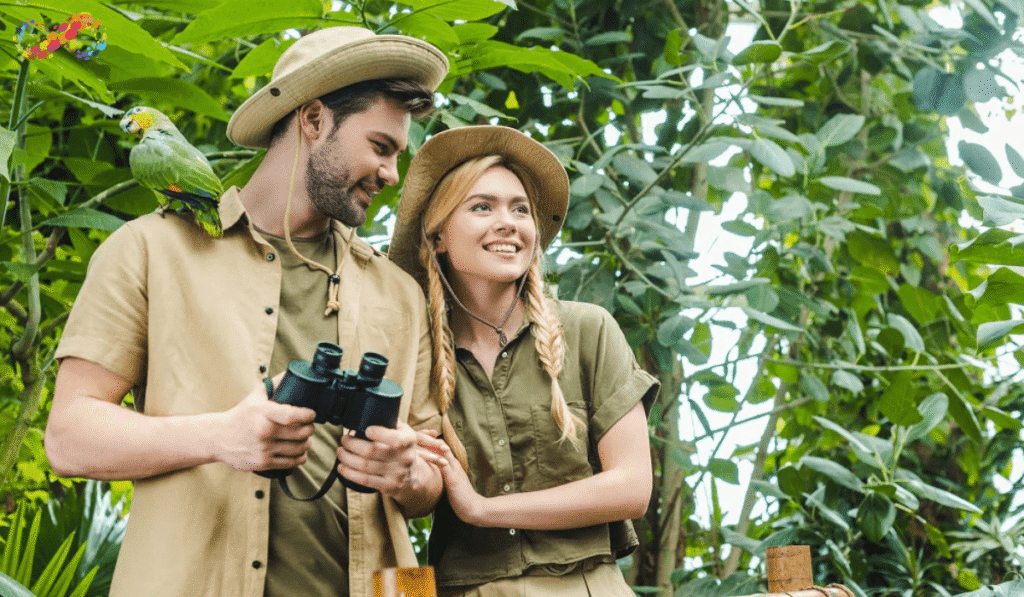You’re deep in the Kenyan bush, spotting a pride of lions lounging in the shade, but your bright top ends up startling them away. Moments like that remind you why the right safari outfit matters—it keeps you comfortable and in the game for every thrilling game drive. Heading to places like the Maasai Mara or Amboseli? Your African safari wardrobe can make the whole trip one for the books.
Safari outfits strike that sweet spot between being practical and a bit stylish. They guard against the sun, dust, and those cooler nights, helping you fade into the landscape like you were meant to be there. The key is choosing items that adapt to whatever surprises the wilderness has in store.
Why Your Safari Looks Matter So Much

Kenya’s wild spots aren’t forgiving. Mornings might feel brisk, afternoons turn scorching, and your gear has to roll with those changes. Fabrics that breathe well, pull away sweat, and cut out UV rays let you focus on the fun without any distractions.
Mess it up, though, and you’re asking for trouble. Dark shades can make your safari tour outfit feel like an oven, while flashy colors might spook animals right when you’re in the middle of a safari game drive outfits experience. Sticking to neutrals and thoughtful choices keeps everything smooth, comfortable, and in harmony with the wildlife.
Colors and Fabrics That Elevate Your Safari Fits
To really merge with the savannah, go for those grounded colors like khaki, beige, olive green, or tan. They mask dirt and help you stay under the radar with the animals. Black pulls in too much heat, blue could attract tsetse flies in certain areas, and white picks up every speck of dust—better to reserve it for relaxing at the lodge. As for camouflage? It’s often linked to military stuff in African spots, so best to skip it.
On the fabric side, lightweight cotton or linen keeps things airy during the heat. Synthetic blends that wick moisture dry out quickly if a surprise rain hits. Lots of safari outfits feature UPF protection to ward off burns and keep your skin in good shape.
Layering turns out to be a real game-changer. Start with a base tee that handles sweat, add a long-sleeved shirt, and throw on a light fleece for when it cools down—perfect for Kenya’s unpredictable shifts.
Putting Together Your African Safari Outfit: The Essentials
Keep your packing smart and minimal—think 5-7 outfits to get through a week without extra bulk. Those small planes in Kenya usually cap luggage at 15-20 kg, so make every item count.
Long-sleeved shirts form the backbone of your safari adventure fit. They shield from thorns, insects, and rays. Team them with pants that convert to shorts via zippers for easy adjustments as temps rise.
Women might enjoy adding a safari dress for a bit of flair—opt for something knee-length and easy-breathing that doesn’t restrict movement. For guys, cargo pants with plenty of pockets are ideal for tucking away essentials like sunscreen or notes.
Base layers deserve attention too. Underwear and socks that manage moisture prevent irritation on those extended drives. A scarf can multitask as a neck cover or dust shield, making it a worthy addition.
Clothes to Wear on Safari: Breaking It Down Day by Day
Mornings often kick off chilly, so layer a long-sleeved shirt over a basic tee, slip into pants, and don’t forget a hat. As the day warms, shed the top layer but keep those sleeves rolled down to block the sun.
Afternoon game drives can get intense with the heat, so lighter safari travel clothes make sense. Shorts and a simple tee are fine in an open jeep, but for walks, cover up to avoid scrapes from bushes.
Camp evenings tend to cool off, so add a fleece or lightweight jacket to your daytime setup. If there’s a pool at the lodge, bring along swimwear for some downtime.
During Kenya’s rainy stretch from March to May, a compact waterproof jacket is a must—it packs small and handles unexpected showers without hassle.
What Shoes to Wear on Safari: Choosing the Right Pair
The terrain out there is no joke for your feet, so closed-toe options are essential to keep out bugs and sharp bits.
Hiking boots or trail runners offer solid ankle support for any bush treks—choose ones that let air flow to avoid sweaty discomfort. Regular sneakers can handle jeep-based safaris, but ensure they’ve got decent tread for muddy paths.
For chilling at the lodge in the evenings, comfortable sandals provide a welcome switch. Avoid flip-flops for active times; they leave too much exposed.
Socks play a big role here. Go for moisture-wicking ones that hit at the ankle to cut down on blisters and add extra defense against insects.
Accessories to Boost Your Safari Wardrobe
The right add-ons can transform straightforward safari fits into fully functional gear. A broad-brimmed hat with a strap stays put even on bumpy rides, protecting your face and neck from harsh rays.
UV-protective sunglasses are non-negotiable—polarized ones help slice through the bright glare of the plains. Slather on SPF 50+ sunscreen without holding back.
Bug spray is key for warding off mosquitoes, particularly around sunset. DEET formulas do the trick, and a head net comes in handy in swarm-prone zones.
Binoculars and a camera strap let you keep hands free while soaking it all in. A refillable water bottle ensures you stay hydrated and cuts down on trash.
How to Dress for a Safari in Kenya: Tips for Different Parks
Every park in Kenya has its unique feel. In the Maasai Mara’s wide-open grasses, dust flies everywhere, so breathable Kenya safari clothes and long pants help fend off irritating blades.
Amboseli’s dry, dusty areas mean a scarf for mouth coverage is smart. Humid coastal spots like Tsavo call for super-light fabrics to stay comfortable.
Seasons change things up. Dry periods from June to October allow for fewer layers, but wet times require rain protection. Always peek at the weather ahead.
Show respect for local folks too. Around villages near parks, modest safari clothes Kenya—like pieces that cover shoulders and knees—go a long way during interactions.
Common Pitfalls to Avoid in Your Safari Outfit Picks
First-timers sometimes grab trendy items that flop in the field. Prioritize usefulness over looks. Denim jeans weigh a ton, trap heat, and take forever to dry—better off without them.
Skipping layers can ruin the vibe, as one set won’t handle Kenya’s ups and downs. Test out your clothes for safari in advance to confirm they fit well and feel good.
Overloading your bag hits snags with strict flight limits. Use soft, squishable duffels and count on lodge washing services to keep things fresh.
Flashy jewelry or bold add-ons distract from the animals. Keep accessories simple to stay immersed.
See More Outfits with Plaid Pants: Timeless Fall Style and Modern Outfit Ideas
Packing Tips: What to Take on Safari for Smooth Travels
A simple checklist eases the process. Group your stuff into categories like clothing, shoes, and extras.
| Category | Essentials | Quantity Suggestion |
|---|---|---|
| Tops | Long-sleeved shirts, tees | 4-6 |
| Bottoms | Pants, shorts | 3-4 pairs |
| Outerwear | Fleece, rain jacket | 1-2 |
| Footwear | Hiking shoes, sandals | 2 pairs |
| Accessories | Hat, sunglasses, repellent | As needed |
This setup keeps you agile and adaptable. Rolling your clothes saves room and reduces creases. Include a mini sewing kit for any on-the-spot repairs.
Neutrals simplify mixing outfits. A single pair of beige pants can work with various tops, expanding your African safari outfit choices.
Remember must-haves like meds and personal items. Anti-malarial pills and a small first-aid setup fit neatly in pockets.
Your safari outfits ought to enhance the experience, not hinder it. With these selections, you’ll melt into the scenery, primed for all the awe-inspiring sights the wild offers.
FAQ
Q: What clothes to wear on safari in Kenya?
Opt for neutral, airy layers such as long-sleeved shirts and pants in khaki or green. These Kenya safari clothing options protect from sun and insects while helping you blend in.
Q: How to wear a safari dress comfortably?
Choose a relaxed, knee-length safari dress made from breathable material. Add leggings underneath for more coverage during drives, blending ease with function.
Q: What to wear on African safari for game drives?
For safari game drive outfits, include long pants, a hat, and layered tops. Natural tones ensure comfort and subtlety as temperatures fluctuate.
Q: What shoes to wear on safari?
Select closed-toe hiking shoes or boots with good grip. They safeguard against thorns and provide stability on rough ground.
Q: What to wear on safari Kenya during rainy season?
Include waterproof jackets and fast-drying pants in your safari outfits. Layers help adapt to variable conditions.
Q: Clothing for Kenya safari: What fabrics work best?
Breathable cotton or synthetic mixes excel in Kenya safari clothes. They manage sweat and offer sun defense for extended comfort.
Q: Safari adventure fit: How many outfits do I need?
Aim for 5-7 flexible items in your African safari wardrobe. They allow easy combinations for a week’s worth without excess baggage.
Q: What to wear for safari evenings at camp?
Add a fleece or light jacket to your daytime wear. This adjusts your safari looks seamlessly for dropping temperatures.
Q: Safari clothes Kenya: Avoid these colors?
Steer clear of vibrant shades, black, or blue in your safari travel clothes. They can draw heat or bugs, throwing off your trip.
Q: How to dress for a safari walking tour?
Go with long pants, sturdy shoes, and a hat. This safari outfit arrangement protects from vegetation and exposure.

